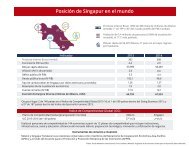basic-guide-to-exporting_Latest_eg_main_086196
basic-guide-to-exporting_Latest_eg_main_086196
basic-guide-to-exporting_Latest_eg_main_086196
Create successful ePaper yourself
Turn your PDF publications into a flip-book with our unique Google optimized e-Paper software.
Documentation must be precise because slight discrepancies or omissions mayprevent merchandise from being exported, may result in nonpayment, or may evenresult in the seizure of the exporter’s goods by U.S. or foreign cus<strong>to</strong>ms officials.Collection documents are subject <strong>to</strong> precise time limits and may not be honored bya bank if the time has expired. Most documentation is routine for freight forwardersand cus<strong>to</strong>ms brokers, but as the exporter, you are ultimately responsible for theaccuracy of the necessary documents.The number and kinds of documents that the exporter must deal with vary according<strong>to</strong> the destination of the shipment. Because each country has different importr<strong>eg</strong>ulations, the exporter must be careful <strong>to</strong> provide all proper documentation.Remember <strong>to</strong> contact your local U.S. Commercial Service office for up-<strong>to</strong>-date foreignimport information.Air WaybillCovers an air freight shipment and can never be made n<strong>eg</strong>otiable.Bill of LadingA contract between the owner of the goods and the carrier (as with domesticshipments). For shipment by vessel, there are two types: a straight bill of lading,which is not n<strong>eg</strong>otiable and does not give title <strong>to</strong> the goods, and a n<strong>eg</strong>otiable, orshipper’s order, bill of lading. The latter can be bought, sold, or traded while th<strong>eg</strong>oods are in transit. The cus<strong>to</strong>mer usually needs an original bill of lading as proof ofownership <strong>to</strong> take possession of the goods.Commercial InvoiceA bill for the goods from the seller <strong>to</strong> the buyer. Many governments use commercialinvoices <strong>to</strong> determine the true value of goods when assessing cus<strong>to</strong>ms duties.Governments that use the commercial invoice <strong>to</strong> control imports will often specifythe invoice’s form, content, and number of copies; language <strong>to</strong> be used; and othercharacteristics.Consular InvoiceRequired document in some countries. Describes the shipment of goods and showsinformation such as the consignor, consignee, and value of the shipment. Certified bythe consular official of the foreign country, it is used by the country’s cus<strong>to</strong>ms officials<strong>to</strong> verify the value, quantity, and nature of the shipment.Certificate of Free SaleRequired in some countries for certain kinds of goods. Your state government usuallysupplies this document, which indicates that the goods you intend <strong>to</strong> export havebeen sold in that state.138U.S. Commercial Service • A Basic Guide <strong>to</strong> Exporting





